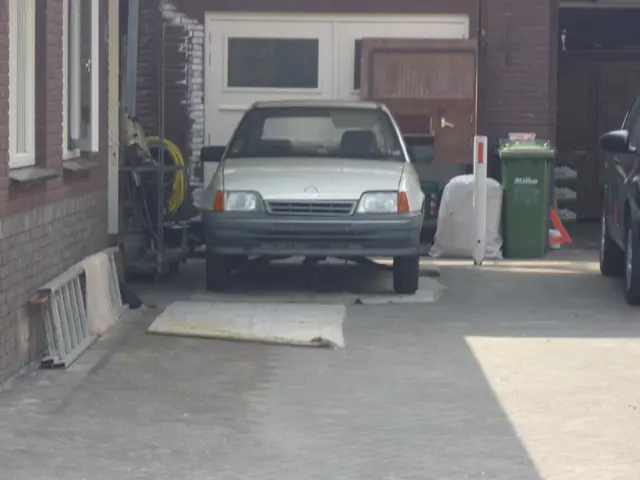Financingboost for innovative artistic sectors
The creative industries in the UK, excluding IT, software, and computer services, have seen little venture capital investment, with a significant concentration in London and the South East. However, concerted government efforts aim to address this imbalance, focusing on boosting investment readiness and infrastructure development outside London.
The UK government's Creative Industries Sector Plan, launched in 2023, aims to nearly double creative industry investment overall by 2035. This ambitious plan includes expanding regional funding programs and targets a boost in innovation, R&D, skills, regional growth, and access to finance in the creative sectors across the UK [1].
One such initiative is the £17.5 million Creative Growth Programme, extended to cover 12 UK regions beyond the initial 6, which focuses on unlocking growth potential in creative businesses outside London. While it has improved investment readiness for some firms, evidence suggests it has had little impact on increasing equity investment or investor willingness in these regions so far [2].
A new £150 million Creative Places Growth Fund, devolved to six Mayoral Combined Authorities, is being used to support creative infrastructure and regional development, signaling increased regional investment efforts [3][4]. Other initiatives within the Sector Plan emphasize support for geographic creative "superclusters" such as the Thames Estuary, the North West, and regions extending to South Wales, aiming to spread economic benefits beyond London [4].
Despite these public funding efforts, private venture capital investment still faces barriers due to perceptions of creative businesses’ commercial viability and dependence on key individuals, limiting the flow of private capital outside London's established centres [2].
The Creative PEC's 'State of the Nations' series, which analyses data across four thematic areas, has also shed light on the creative economy. The reports suggest that re-imagining growth finance could boost the creative economy and help tackle regional inequality in support of the UK's Government's growth mission [5].
Notably, the report "Growth Finance for Creative Industries" proposes that re-imagining growth finance could boost the creative economy [6]. Creative businesses are more likely to identify new R&D opportunities than businesses in other sectors but may face barriers in accessing the capital they need to act upon these [7].
The report "Skills Mismatches in the UK's Creative Industries" examines skills mismatches in the UK's creative industries, while "Creative Further Education in the four UK nations" looks at student participation in creative further education in the four UK nations [8][9]. The report "Arts, Culture and Heritage: Audiences and Workforce" explores the role of arts, culture, and heritage in the UK, and "Higher Education and the Arts and Culture Sectors" considers the important role that higher education plays in the arts and culture sectors [10][11].
As the UK navigates its position in the global creative economy, reports such as "UK Trade in a Global Creative Economy," "International, Trade, and Immigration: Migration in UK Creative Occupations and Industries," and "Foreign Direct Investment in the UK's Creative Industries" provide valuable insights [12][13][14]. The report "Geographies of Creativity" explores how place matters when it comes to creativity [15].
The Creative PEC State of the Nations report, authored by Dr Josh Siepel (University of Sussex and the Creative PEC), Dr Sawan Rathi (University of Sussex), and Professor Marc Cowling (Oxford Brookes University), analyses the state of the creative economy in the UK [16]. The reports' findings underscore the need for continued efforts to address regional disparities in venture capital investment and to support the growth and development of the creative industries across the UK.
References: [1] Siepel, S, Rathi, S and Cowling, M (2024) 'Growth finance for the creative industries', Creative PEC State of the Nations Research Series. United Kingdom: Creative Industries Policy and Evidence Centre (Creative PEC). DOI:10.5281/Zenodo.13889750. [2] Creative Industries Council (2024) 'Creative Industries Sector Deal Evaluation: Final Report'. London: Department for Digital, Culture, Media and Sport. [3] HM Treasury (2024) 'Creative Industries Sector Deal: £150 million Creative Places Growth Fund'. London: HM Treasury. [4] Department for Digital, Culture, Media and Sport (2024) 'Creative Industries Sector Deal: A New Deal for Creative Britain'. London: Department for Digital, Culture, Media and Sport. [5] Creative Industries Policy and Evidence Centre (2024) 'State of the Nations 2024: Creative Industries in the UK'. London: Creative Industries Policy and Evidence Centre. [6] Siepel, J, Rathi, S and Cowling, M (2024) 'Growth finance for the creative industries', Creative PEC State of the Nations Research Series. United Kingdom: Creative Industries Policy and Evidence Centre (Creative PEC). DOI:10.5281/Zenodo.13889750. [7] Creative Industries Policy and Evidence Centre (2024) 'State of the Nations 2024: Creative Industries in the UK'. London: Creative Industries Policy and Evidence Centre. [8] Creative PEC (2024) 'Creative Further Education in the four UK nations'. London: Creative Industries Policy and Evidence Centre. [9] Creative PEC (2024) 'Skills Mismatches in the UK's Creative Industries'. London: Creative Industries Policy and Evidence Centre. [10] Creative PEC (2024) 'Arts, Culture and Heritage: Audiences and Workforce'. London: Creative Industries Policy and Evidence Centre. [11] Creative PEC (2024) 'Higher Education and the Arts and Culture Sectors'. London: Creative Industries Policy and Evidence Centre. [12] Creative PEC (2024) 'UK Trade in a Global Creative Economy'. London: Creative Industries Policy and Evidence Centre. [13] Creative PEC (2024) 'International, Trade, and Immigration: Migration in UK Creative Occupations and Industries'. London: Creative Industries Policy and Evidence Centre. [14] Creative PEC (2024) 'Foreign Direct Investment in the UK's Creative Industries'. London: Creative Industries Policy and Evidence Centre. [15] Creative PEC (2024) 'Geographies of Creativity'. London: Creative Industries Policy and Evidence Centre. [16] Creative PEC (2024) 'State of the Nations 2024: Creative Industries in the UK'. London: Creative Industries Policy and Evidence Centre.
- The UK government's Creative Industries Sector Plan aims to increase investment in the creative sectors, focusing on innovation, R&D, skills, regional growth, and access to finance.
- One strategy to boost investment is the expansion of regional funding programs, such as the Creative Growth Programme, which extends to 12 UK regions and focuses on unlocking growth potential in creative businesses outside London.
- The Creative Places Growth Fund, devolved to six Mayoral Combined Authorities, supports creative infrastructure and regional development, with a goal of addressing regional disparities in investment.
- Other initiatives within the Sector Plan include the creation of geographic creative "superclusters" to spread economic benefits beyond London.
- Despite these public funding efforts, perceptions of creative businesses' commercial viability and dependence on key individuals continue to limit the flow of private capital outside London's established centres.
- A report suggests re-imagining growth finance could boost the creative economy and help tackle regional inequality, aligning with the UK government's growth mission.
- Creative businesses are more likely to identify new R&D opportunities than businesses in other sectors, but may face barriers in accessing the capital they need to act upon these opportunities.
- Reports such as "UK Trade in a Global Creative Economy," "International, Trade, and Immigration: Migration in UK Creative Occupations and Industries," and "Foreign Direct Investment in the UK's Creative Industries" provide valuable insights into the UK's position in the global creative economy.
- The Creative PEC State of the Nations report, authored by Dr Josh Siepel, Dr Sawan Rathi, and Professor Marc Cowling, analyses the state of the creative economy in the UK and underscores the need for continued efforts to address regional disparities in venture capital investment.
- As the UK navigates its position in the global creative economy, it is important to consider the role that arts, culture, and heritage play in the UK, as well as the important role that higher education plays in the arts and culture sectors.




